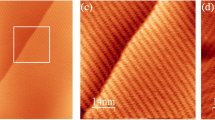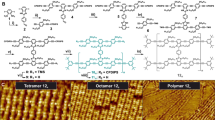Abstract
Supramolecular assembly can yield ordered structures by taking advantage of the cumulative effect of multiple non-covalent interactions between adjacent molecules. The thermodynamic origin of many self-assembled structures in water is the balance between the hydrophilic and hydrophobic segments of the molecule. Here, we show that this approach can be generalized to use solvophobic and solvophilic segments of fully hydrophobic alkylated fullerene molecules. Addition of n-alkanes results in their assembly—due to the antipathy of C60 towards n-alkanes—into micelles and hexagonally packed gel-fibres containing insulated C60 nanowires. The addition of pristine C60 instead directs the assembly into lamellar mesophases by increasing the proportion of π-conjugated material in the mixture. The assembled structures contain a large fraction of optoelectronically active material and exhibit comparably high photoconductivities. This method is shown to be applicable to several alkyl–π-conjugated molecules, and can be used to construct organized functional materials with π-conjugated sections.
This is a preview of subscription content, access via your institution
Access options
Subscribe to this journal
Receive 12 print issues and online access
$259.00 per year
only $21.58 per issue
Buy this article
- Purchase on Springer Link
- Instant access to full article PDF
Prices may be subject to local taxes which are calculated during checkout




Similar content being viewed by others
Change history
25 June 2014
In the version of this Article originally published, the units on the y axes of Figs 1d and 2c were incorrect; they should have read cm–1. This has been corrected in all versions of the Article.
References
Rothemund, P. W. K. Folding DNA to create nanoscale shapes and patterns. Nature 440, 297–302 (2006).
Sobczak, J-P. J., Martin, T. G., Gerling, T. & Dietz, H. Rapid folding of DNA into nanoscale shapes at constant temperature. Science 338, 1458–1461 (2012).
Aida, T., Meijer, E. W. & Stupp, S. I. Functional supramolecular polymers. Science 335, 813–817 (2012).
Du, G., Moulin, E., Jouault, N., Buhler, E. & Giuseppone, N. Muscle-like supramolecular polymers: integrated motion from thousands of molecular machines. Angew. Chem. Int. Ed. 51, 12504–12508 (2012).
Wang, C., Wang, Z. & Zhang, X. Amphiphilic building blocks for self-assembly: from amphiphiles to supra-amphiphiles. Acc. Chem. Res. 45, 608–618 (2012).
Israelachvili, J. in Surfactants in Solution (eds Mittal, K. L. & Bothorel, P.) 3–33 (Springer, 1987).
Altoe, V., Martin, F., Katan, A., Salmeron, M. & Aloni, S. Electron microscopy reveals structure and morphology of one molecule thin organic films. Nano Lett. 12, 1295–1299 (2012).
Henson, Z. B., Müllen, K. & Bazan, G. C. Design strategies for organic semiconductors beyond the molecular formula. Nature Chem. 4, 699–704 (2012).
Pisula, W., Feng, X. & Müllen, K. Tuning the columnar organization of discotic polycyclic aromatic hydrocarbons. Adv. Mater. 22, 3634–3649 (2010).
Percec, V. et al. Self-organization of supramolecular helical dendrimers into complex electronic materials. Nature 419, 384–387 (2002).
Saez, I. M. & Goodby, J. W. Supermolecular liquid crystals. J. Mater. Chem. 15, 26–40 (2005).
Guillon, D., Donnio, B. & Deschenaux, R. in Supramolecular Chemistry of Fullerenes and Carbon Nanotubes (eds Martín, N. & Nierengarten, J-F.) 203–235 (Wiley-VCH, 2012).
Binks, B. P., Fletcher, P. D. I., Kotsev, S. N. & Thompson, R. L. Adsorption and aggregation of semifluorinated alkanes in binary and ternary mixtures with hydrocarbon and fluorocarbon solvents. Langmuir 13, 6669–6682 (1997).
Blanazs, A., Armes, S. P. & Ryan, A. J. Self-assembled block copolymer aggregates: from micelles to vesicles and their biological applications. Macromol. Rapid Commun. 30, 267–277 (2009).
Nakanishi, T. Supramolecular soft and hard materials based on self-assembly algorithms of alkyl-conjugated fullerenes. Chem. Commun. 46, 3425–3436 (2010).
Li, H. et al. Alkylated-C60 based soft materials: regulation of self-assembly and optoelectronic properties by chain branching. J. Mater. Chem. C 1, 1943–1951 (2013).
Vergara, J. et al. Liquid-crystalline hybrid materials based on [60]fullerene and bent-core structures. Angew. Chem. Int. Ed. 50, 12523–12528 (2011).
Li, H., Choi, J. & Nakanishi, T. Optoelectronic functional materials based on alkylated-π molecules: self-assembled architectures and nonassembled liquids. Langmuir 29, 5394–5406 (2013).
Zhong, Y-W., Matsuo, Y. & Nakamura, E. Lamellar assembly of conical molecules possessing a fullerene apex in crystals and liquid crystals. J. Am. Chem. Soc. 129, 3052–3053 (2007).
Ruoff, R. S., Tse, D. S., Malhotra, R. & Lorents, D. C. Solubility of fullerene (C60) in a variety of solvents. J. Phys. Chem. 97, 3379–3383 (1993).
Kordatos, K., Da Ros, T., Prato, M., Bensasson, R. V. & Leach, S. Absorption spectra of the mono-adduct and eight bis-adduct regioisomers of pyrrolidine derivatives of C60 . Chem. Phys. 293, 263–280 (2003).
Sedov, I. A., Stolov, M. A. & Solomonov, B. N. Solvophobic effects and relationships between the Gibbs energy and enthalpy for the solvation process. J. Phys. Org. Chem. 24, 1088–1094 (2011).
Moyá, M. L., Rodríguez, A., Graciani, M. del M. & Fernández, G. Role of the solvophobic effect on micellization. J. Colloid Interface Sci. 316, 787–795 (2007).
Hollamby, M. J. Practical applications of small-angle neutron scattering. Phys. Chem. Chem. Phys. 15, 10566–10579 (2013).
Guinier, A. La diffraction des rayons X aux tres petits angles: Application a l'étude de phénomenes ultramicroscopiques. Ann. Phys. 12, 161–237 (1939).
Hyde, S. T. in Handbook of Applied Surface and Colloid Chemistry Vol. 1–2, 299–332 (Wiley, 2001).
Ishi-i, T., Ono, Y. & Shinkai, S. Chirally-ordered fullerene assemblies found in organic gel systems of cholesterol-appended [60]fullerenes. Chem. Lett. 29, 808–809 (2000).
Yang, X. et al. Self-assembly of a new C60 compound with an L-glutamid-derived lipid unit: formation of organogels and hierarchically structured spherical particles. Soft Matter 7, 3592–3598 (2011).
Newbloom, G. M., Kim, F. S., Jenekhe, S. A. & Pozzo, D. C. Mesoscale morphology and charge transport in colloidal networks of poly(3-hexylthiophene). Macromolecules 44, 3801–3809 (2011).
Saeki, A., Seki, S., Takenobu, T., Iwasa, Y. & Tagawa, S. Mobility and dynamics of charge carriers in rubrene single crystals studied by flash-photolysis microwave conductivity and optical spectroscopy. Adv. Mater. 20, 920–923 (2008).
Babu, S. S., Saeki, A., Seki, S., Möhwald, H. & Nakanishi, T. Millimeter-sized flat crystalline sheet architectures of fullerene assemblies with anisotropic photoconductivity. Phys. Chem. Chem. Phys. 13, 4830–4834 (2011).
Zhang, X. et al. Flowerlike supramolecular architectures assembled from C60 equipped with a pyridine substituent. Chem. Commun. 46, 8752–8754 (2010).
Babu, S. S., Prasanthkumar, S. & Ajayaghosh, A. Self-assembled gelators for organic electronics. Angew. Chem. Int. Ed. 51, 1766–1776 (2012).
Park, C., Song, H. J. & Choi, H. C. The critical effect of solvent geometry on the determination of fullerene (C60) self-assembly into dot, wire and disk structures. Chem. Commun. 4803–4805 (2009).
Lei, T. & Pei, J. Solution-processed organic nano- and micro-materials: design strategy, growth mechanism and applications. J. Mater. Chem. 22, 785–798 (2012).
Vera, F. et al. Microstructured objects produced by the supramolecular hierarchical assembly of an organic free radical gathering hydrophobic–amphiphilic characteristics. Chem. Sci. 3, 1958–1962 (2012).
Sathish, M., Miyazawa, K., Hill, J. P. & Ariga, K. Solvent engineering for shape-shifter pure fullerene (C60). J. Am. Chem. Soc. 131, 6372–6373 (2009).
Balakrishnan, K. et al. Effect of side-chain substituents on self-assembly of perylene diimide molecules: morphology control. J. Am. Chem. Soc. 128, 7390–7398 (2006).
Hollamby, M. J. et al. Tri-chain hydrocarbon surfactants as designed micellar modifiers for supercritical CO2 . Angew. Chem. Int. Ed. 48, 4993–4995 (2009).
Ryoo, W., Webber, S. E. & Johnston, K. P. Water-in-carbon dioxide microemulsions with methylated branched hydrocarbon surfactants. Ind. Eng. Chem. Res. 42, 6348–6358 (2003).
Nurmawati, M. H., Ajikumar, P. K., Renu, R., Sow, C. H. & Valiyaveettil, S. Amphiphilic poly(p-phenylene)-driven multiscale assembly of fullerenes to nanowhiskers. ACS Nano 2, 1429–1436 (2008).
Kawauchi, T. et al. Encapsulation of fullerenes in a helical PMMA cavity leading to a robust processable complex with a macromolecular helicity memory. Angew. Chem. Int. Ed. 47, 515–519 (2008).
Tashiro, K. & Aida, T. Metalloporphyrin hosts for supramolecular chemistry of fullerenes. Chem. Soc. Rev. 36, 189–197 (2007).
Giacalone, F. & Martín, N. New concepts and applications in the macromolecular chemistry of fullerenes. Adv. Mater. 22, 4220–4248 (2010).
Patterson, A. L. The Scherrer formula for X-ray particle size determination. Phys. Rev. 56, 978 (1939).
Hirata, S. et al. Improvement of electroluminescence performance of organic light-emitting diodes with a liquid-emitting layer by introduction of electrolyte and a hole-blocking layer. Adv. Mater. 23, 889–893 (2011).
Babu, S. S. et al. Nonvolatile liquid anthracenes for facile full-colour luminescence tuning at single blue-light excitation. Nature Commun. 4, 1969 (2013).
Burghardt, S., Hirsch, A., Schade, B., Ludwig, K. & Böttcher, C. Switchable supramolecular organization of structurally defined micelles based on an amphiphilic fullerene. Angew. Chem. Int. Ed. 44, 2976–2979 (2005).
Nierengarten, J.-F. Chemical modification of C60 for materials science applications. New J. Chem. 28, 1177–1191 (2004).
Zhao, C. et al. Do deuteriums form stronger CH–π interactions? J. Am. Chem. Soc. 134, 14306–14309 (2012).
Acknowledgements
This work was partially supported by KAKENHI (25620069, 25104011) from the MEXT, Japan. M.H. also thanks the Japan Society for the Promotion of Science (JSPS) and NIMS International Center for Young Scientists (ICYS) for funding. The SPring-8 synchrotron radiation experiment was performed on BL40B2 with the approval the Japan Synchrotron Radiation Research Institute (JASRI; proposal no. 2011B1548). The authors thank the beamline contact (N. Ohta, SPring8) for his help with performing SAXS measurements. The authors also thank H. Li (MPI), H. Ozawa, Y. Akasaka, M. Matsuda, J. Aimi and M. Takeuchi (NIMS) for helpful discussions, M. Ohnuma and T. Taguchi (NIMS) for use of the for Rigaku SAXS equipment and rheometer respectively, the Soft Materials Line and the MANA TSS Group at NIMS for use of spectroscopic facilities, and the STFC and Institut Laue Langevin for beam time on D11 at ILL.
Author information
Authors and Affiliations
Contributions
M.J.H. and T.N. are joint principal investigators; they designed the work, carried out research, analysed data and wrote the paper. M.K. helped to characterize the lamellar mesophases. P.H.H.B. and N.A.J.M.S. performed the cryo-TEM experiments. A.S. and S.S. performed the TRMC studies. H.Mi. contributed to the temperature-dependent XRD studies. I.G., P.B. and J.E. helped acquire the SANS data and advised on presentation and English. B.R.P. helped acquire, reduce and analyse the SAXS data. H.Mö. was involved in developing the concept and in discussions about the work. All authors discussed the results and commented on the manuscript.
Corresponding authors
Ethics declarations
Competing interests
The authors declare no competing financial interests.
Supplementary information
Supplementary information
Supplementary information (PDF 3356 kb)
Rights and permissions
About this article
Cite this article
Hollamby, M., Karny, M., Bomans, P. et al. Directed assembly of optoelectronically active alkyl–π-conjugated molecules by adding n-alkanes or π-conjugated species. Nature Chem 6, 690–696 (2014). https://doi.org/10.1038/nchem.1977
Received:
Accepted:
Published:
Issue Date:
DOI: https://doi.org/10.1038/nchem.1977
This article is cited by
-
Dynamic covalent chemistry steers synchronizing nanoparticle self-assembly with interfacial polymerization
Communications Chemistry (2019)
-
Preparation of nano- and microstructures through molecular assembly of cyclic oligosaccharides
Polymer Journal (2018)
-
Water-soluble complex formation of fullerenes with a biocompatible polymer
Polymer Journal (2016)
-
A nanomesh scaffold for supramolecular nanowire optoelectronic devices
Nature Nanotechnology (2016)
-
A slippery molecular assembly allows water as a self-erasable security marker
Scientific Reports (2015)



